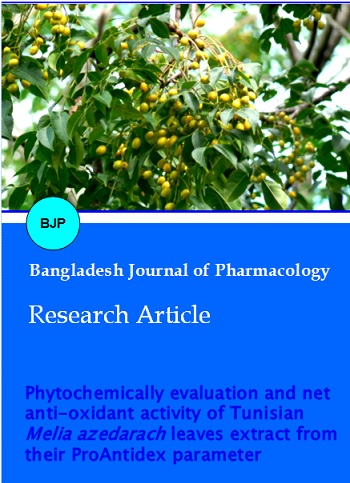Phytochemically evaluation and net antioxidant activity of Tunisian Melia azedarach leaves extract from their ProAntidex parameter
DOI:
https://doi.org/10.3329/bjp.v11i2.25981Keywords:
Anti-oxidant, Melia azedarach, ProAntidex, TunisianAbstract
Phytotherapy is a discipline which is interested in the design, the preparation and the interpretation of structure activity relationship of the natural bioactive molecules. In this context, ethanolic leaves extract of Melia azedarach L. was phytochemically analysed on the bases of HPLC and by GCMS. Extract wase tested for his in vitro antioxidant activities by 1,1-diphenyl-2-picrylhydrazyl (DPPH), H2O2, hydroxyl radical scavenging activity, Ferric Reducing Power (FRP) and Ferrous ion chelating abilities methods. The antioxidant activity of the extract was analyzed simultaneously with their pro-oxidant capacity. The ratio of pro-oxidant to the antioxidant activity (ProAntidex) represents a useful index of the net free radical scavenging potential of the synthesized compounds. Tested extract showed significant antioxidant activity with a moderate ProAntidex.
Video clips of Methodology:
Ferrous ion chelating ability (FIC) 1 Click to watch
Ferrous ion chelating ability (FIC) 2 Click to watch
Ferrous ion chelating ability (FIC) 3 Click to watch
Downloads
589
437 Read
163

Additional Files
Published
How to Cite
Issue
Section
License
Authors who publish with this journal agree to the following terms:
- Authors retain copyright and grant the journal right of first publication with the work simultaneously licensed under a Creative Commons Attribution License that allows others to share the work with an acknowledgement of the work's authorship and initial publication in this journal.
- Authors are able to enter into separate, additional contractual arrangements for the non-exclusive distribution of the journal's published version of the work (e.g., post it to an institutional repository or publish it in a book), with an acknowledgement of its initial publication in this journal.
- Authors are permitted and encouraged to post their work online (e.g., in institutional repositories or on their website) prior to and during the submission process, as it can lead to productive exchanges, as well as earlier and greater citation of published work (See The Effect of Open Access).
